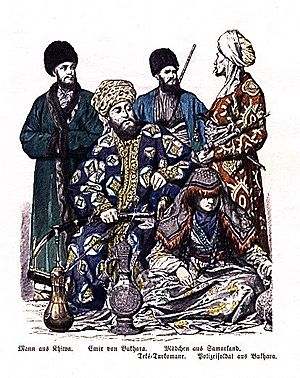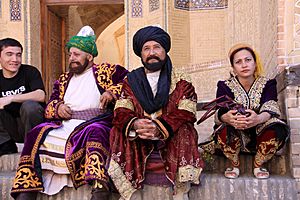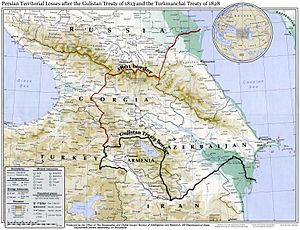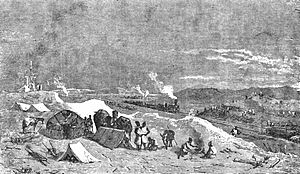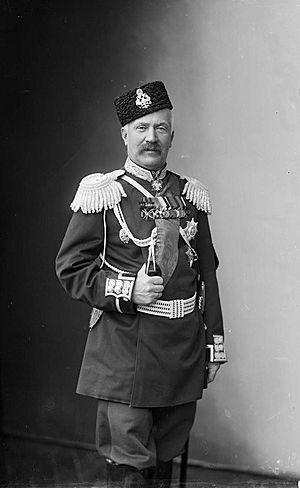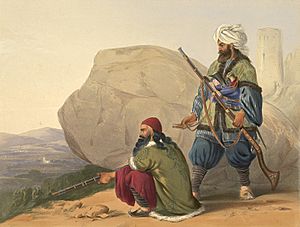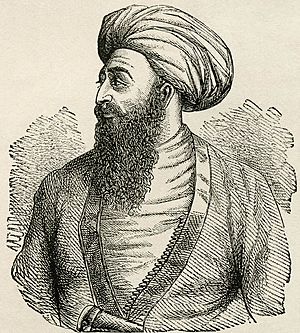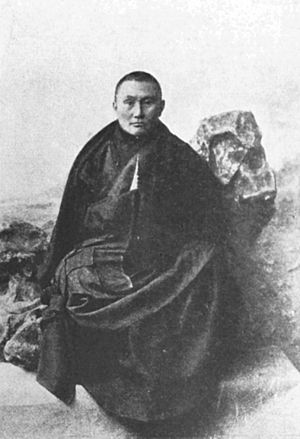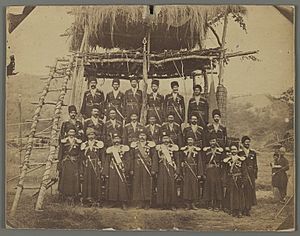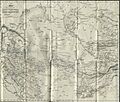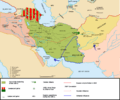Great Game facts for kids
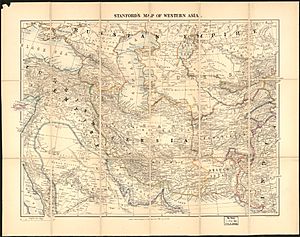
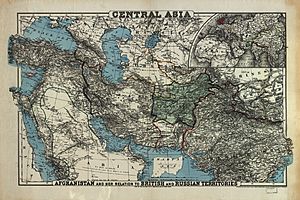
The Great Game was a big rivalry between the British and Russian Empires in the 1800s. They both wanted more power and control in Asia, especially in countries like Afghanistan, Persia, and later Tibet. These two large empires used their armies and talks between leaders to gain and change territories in Central and South Asia. Russia took over Russian Turkestan, and Britain expanded its control over colonial India. By the early 1900s, many independent states and kingdoms from the Caspian Sea to the Eastern Himalayas became controlled or protected by these two empires.
Even though the Great Game involved a lot of mistrust, secret plans, and small wars, Britain and Russia never fought a full-scale war directly against each other. However, they did fight in the Crimean War from 1853 to 1856, which affected their rivalry in Asia. The two empires also worked together sometimes, signing treaties and setting borders, like with the Afghan Boundary Commission.
Britain worried that Russia's expansion south would threaten India, which was a very important colony. Russia, on the other hand, worried about Britain's growing influence in Central Asia. So, Britain focused on protecting all ways into India. Russia kept expanding its control over Central Asia. Russia often used its actions in Asia to try and get what it wanted from Britain in Europe. But after 1801, Russia did not seriously plan to attack India directly.
The rivalry started with Russia's invasions of Iran in 1804–1813 and 1826–1828. This made Persia a battleground for these powerful nations. Many historians say the Great Game officially began on January 12, 1830. On that day, a British official named Lord Ellenborough asked Lord Bentinck, the Governor-General of India, to find a trade route to Bukhara. Britain wanted to make Afghanistan a protected state. They also wanted to support the Ottoman Empire, Persia, Khiva, and Bukhara. These countries would act as buffer states to stop Russia from expanding. This would keep India safe and protect important British sea trade routes. It would also stop Russia from getting a port on the Persian Gulf or the Indian Ocean. As both empires grew and competed, Russia suggested that Afghanistan should be a neutral zone.
The Great Game usually ended between 1895 and 1907. In September 1895, Britain and Russia signed agreements about the border in the Pamir Mountains. This officially set the border between Afghanistan and the Russian Empire. In August 1907, the Anglo-Russian Convention created an alliance between Britain and Russia. This agreement formally decided who controlled Afghanistan, Persia, and Tibet.
Contents
- What's in a Name?
- Early Worries About India
- How the Game Began
- Early Explorations
- First Anglo-Afghan War
- Anglo-Sikh Wars
- Anglo-Persian War
- Further Expansion
- Tibet and Inner Asia
- Persia
- Second Anglo-Afghan War
- Diplomacy
- When Did the Great Game Happen?
- How the Great Game Shaped Today's Borders
- Images for kids
- See also
What's in a Name?
The name Great Game was first used by a British intelligence officer, Arthur Conolly, in 1840. The famous novel Kim by Rudyard Kipling in 1901 made the term very popular. It became even more well-known after the Soviet–Afghan War started in 1979.
The term "Great Game" was used even before the 1800s. It was linked to risky games like cards or dice. The French phrase "Le grand jeu" (The great game) goes back to at least 1585. It means something involving risk, chance, and trickery.
In July 1840, Arthur Conolly wrote to another officer, Henry Rawlinson. Conolly said, "You've a great game, a noble game, before you." He believed Rawlinson's new job in Afghanistan was a chance to help people.
Early Worries About India
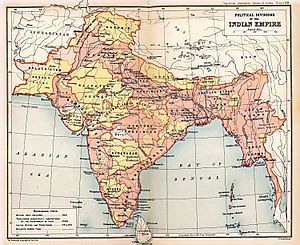
At the start of the 1800s, parts of India were ruled by independent states. Other parts were controlled by the British East India Company. During the 1800s, Britain and Russia started a political fight over Afghanistan. This became known as "The Great Game." Russia thought Britain would try to control trade and military routes into Central Asia. Britain thought Russia would try to take India, which was called the "jewel in the crown" of the British Empire. This led to a lot of mistrust and the constant threat of war. The British believed that if Russia controlled Afghanistan, it could use it as a base to invade India.
Napoleon had even suggested a joint French-Russian invasion of India to the Russian ruler, Tsar Paul I. In 1801, Tsar Paul decided to act first against Britain. He ordered his Cossack troops to march towards India. But Tsar Paul was killed that same year, and the invasion was stopped.
Historian Peter Hopkirk wrote that Tsar Paul didn't even have a detailed map of India. He told his general, "My maps only go as far as Khiva and the River Oxus. Beyond these points it is your affair to gain information." The British public learned about this much later. But it made them very suspicious of Russia.
Napoleon tried to convince Tsar Paul's son, Tsar Alexander I, to invade India. But Alexander refused. In 1807, Napoleon sent a French military group to Persia to try and get Russia to invade India. In response, Britain sent its own diplomats and military advisors to Persia and Afghanistan in 1808. This stopped the possible French and Russian threat to India. But Britain still worried about defending its colony. At the same time, Russia fought wars with Persia from 1804-1813, which added to Britain's fears.
In 1810, British officers Henry Pottinger and Charles Christie traveled through Balochistan and Persia disguised as Muslims. The East India Company paid for this trip to map and study these areas. They worried about a French invasion of India from that direction. After Napoleon's army was defeated in Russia in 1812, the French threat through Persia disappeared.
The Shah of Iran, Fath-Ali Shah Qajar, was caught in the middle of these diplomatic games. He first got some British support, but it was canceled after Russia invaded Persia in 1804. Then, he promised Napoleon in 1807 that he would invade British India if France helped him militarily. But this plan also failed. When France allied with Russia in 1807, the Shah turned back to Britain. In a treaty in 1809, Persia agreed to stop any European army from passing through to India. Britain agreed to train Persian soldiers and pay Persia if it was invaded by a European country. However, Russia still defeated Iran a few years later.
The Russo-Persian Wars became a major point of tension between Britain and Russia. Especially after the Treaty of Gulistan in 1813, Russia gained the right to interfere in Persia. This was a big humiliation for Persia. Fath-Ali Shah tried to balance Russia's power by getting closer to Britain. Britain offered military and financial help to Iran. They wanted Iran to be a buffer between Russia and India. The Russian invasion of Iran in 1826-1828 led to another Russian victory. This made Qajar Iran very weak and put Persia fully into the competition between Russia and Britain.
How the Game Began
Britain's View
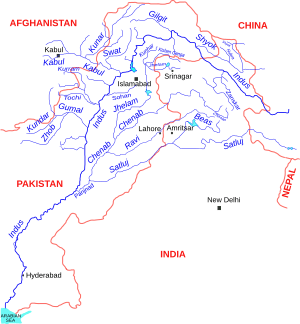
Many say the Great Game started on January 12, 1830. That's when Lord Ellenborough, a British official, asked Lord William Bentinck, the Governor-General of India, to find a new trade route to Bukhara.
After treaties in 1828 and 1829, Britain expected that Persia and the Ottoman Empire would become controlled by Russia. This changed how Britain saw the world, and their response was the Great Game. Britain wanted a series of buffer states between its empire and Russia's. These included Turkey, Persia, the Khanate of Khiva, and the Khanate of Bukhara. Britain also wanted to protect states from the Persian Gulf to India and into Afghanistan. British naval power would protect sea trade routes. To reach Afghanistan, Britain planned to use steam-powered boats on the Indus and Sutlej rivers. This meant they needed access through the Sind and Punjab regions. Persia would have to give up its claim on Herat in Afghanistan. Afghanistan needed to become one strong state ruled by a British ally. The Great Game meant Britain would have closer ties with the states on its northwest border.
Britain believed it was the world's first free and most advanced industrial country. They thought they had a duty to develop Central Asia with their goods and values. British goods would bring British values and respect for private property. With jobs and safety, nomads would settle down and become farmers around cities. These cities would grow into modern states with clear borders, like in Europe. So, borders needed to be drawn on maps. Historian David Fromkin said that by the mid-1800s, Britain had many reasons to expect a war with Russia unless Russia's expansion in Asia stopped:
- Russia's growth would make it too powerful.
- Russia might invade India.
- Russian success would encourage anti-British groups in India to revolt.
- It would hurt trade with Asia.
- It could threaten British naval routes that connected the empire.
- Later, oil was found in Central Asia. This oil was vital for the British Navy and economy.
Russia's View
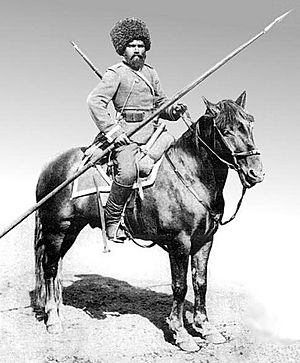
In 1557, Bukhara and Khiva sent ambassadors to Ivan IV to ask for trade with Russia. Russia wanted a trade route from Moscow to India. For centuries, Russian ambassadors tried to free Russians taken as slaves by the khanates. Russia later expanded across Siberia to the Pacific Ocean, reaching Vladivostok by 1859. This eastward expansion did not worry Britain, as it was not on their trade routes.
Starting in the 1820s, Russian troops moved south from Siberia. They wanted secure borders and friendly neighbors. This advance continued until Russia's influence was strong in Central Asia, including Bukhara and Khiva. Between 1824 and 1854, Russia took over the entire Kazakh Khanate (modern-day Kazakhstan). This increased tensions with Khiva, which treated Russian merchants unfairly and held Russian slaves. Russia attacked Khiva in 1839–40, but failed due to the harsh land and weather. However, the ruler of Khiva released some Russian slaves.
In the 1840s and 1850s, Russia wanted Bukhara and Khiva to stop attacking Russia, free Russian slaves, and not give shelter to Kazakhs fleeing Russian law. Russia also wanted its merchants to trade freely and safely in the khanates. They wanted goods to pass easily through Central Asia to other states. They also wanted Russian trade agents to live in Bukhara and Khiva, and Russian ships to sail freely on the Amu Darya river. None of these goals were fully met. Russia's borders remained unsafe, and British influence in the region grew.
In 1869, a British diplomat suggested the Amu Darya river as a neutral zone between British and Russian areas of influence. But a Russian diplomat, Alexander Gorchakov, suggested Afghanistan as the neutral zone instead. Russia worried about the influence a Muslim power with British support might have on other khanates.
The Russian Empire wanted to reach important coastlines like the Black Sea, Persian Gulf, and the Pacific. Russian plans to invade British India were made during the Crimean War in 1854 and 1855. Historian Evgeny Sergeev says the Great Game was a competition that intensified after Russia's defeat in the Crimean War in 1856. Expanding into Central Asia was linked to ambitions in India. Historian Alexandre Andreyev said Russia's fast advance in Central Asia was meant to extend its southern border. It also aimed to distract Britain from a rebellion in Poland. Russian leaders knew that threatening India was a way to get better deals from Britain in Europe.
Like the British, the Russian Empire saw itself as a "civilizing power." They believed they were bringing good behavior to what they saw as a "semi-barbarous" region.
Early Explorations

East India Company Explorers
In 1782, George Forster, a British East India Company worker, traveled from Calcutta, India, through Kashmir, Afghanistan, Persia, and across the Caspian Sea to Russia and London. His detailed journey was published in 1798.
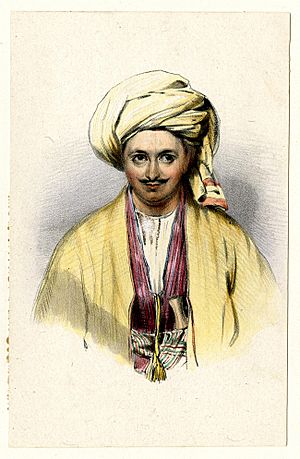
William Moorcroft was an explorer and doctor for the East India Company. He wanted to expand trade in Central Asia, where Russian traders were already active. In 1820, Moorcroft and two others traveled from India to Bukhara to buy horses. They reached Bukhara in 1825, but all three died of fever on the way back. His travels were published in 1841.
In 1829, Lieutenant Arthur Conolly of the East India Company traveled from Russia to the Caspian desert, then through Iran and Afghanistan. He reached the British border in India in January 1831. He published his travels in 1834. After 1830, Britain's trade and diplomatic interest in the northwest grew very strong. In 1831, Captain Alexander Burnes and Colonel Henry Pottinger surveyed the Indus river. This helped prepare for future British actions in the Sind region to open a path to Central Asia.
Burnes went on a dangerous 12-month journey starting in 1831. He traveled into Afghanistan and through the Hindu Kush mountains to Bukhara, returning in 1832. Burnes was one of the first to study Afghanistan for British Intelligence. His book, Travels To Bukhara, became very popular in 1834. Between 1832 and 1834, Britain tried to make trade deals with Ranjit Singh, the ruler of the Sikh empire, and the Amirs of Sindh. But these attempts failed.
Afghanistan and Central Asia
In 1835, Lord Auckland became Governor-General. He was told to "watch more closely" what was happening in Afghanistan and to "counteract the progress of Russian influence." He was given power to interfere in Afghanistan if needed. This was to stop Persia from expanding or to block Russian influence.
In 1837, the Russian envoy Captain Jan Vitkevitch visited Kabul. The British thought he was there to set up a Russian presence in Afghanistan. While in Kabul, he met the British envoy, Captain Alexander Burnes. Burnes reported negatively on Russia's plans. Russia feared British trade in Central Asia. They also worried about the influence a Muslim power with British support might have on other khanates. In 1837, Russian troops took over an island in the southern Caspian Sea.

In 1838, Colonel Charles Stoddart of the East India Company went to the Emirate of Bukhara. He wanted to make an alliance with Nasrullah Khan. But Nasrullah Khan imprisoned Stoddart. In 1841, Captain Arthur Conolly arrived to try and free Stoddart. He was also imprisoned. On June 17, 1842, both men were beheaded. When the Russian Emperor Nicholas I of Russia heard about this, he refused to deal with the Emir of Bukhara. After its two officers were killed, Britain told its officers not to travel in Turkestan.
In 1838, there were rumors in London that Russia would move towards Khiva. Also, Persia wanted to take over Herat. But Herat's loyalty to Afghanistan was very important to Britain. The Siege of Herat began in November 1837. The new Shah of Persia, Mohammed Mirza, arrived at Herat. He wanted to take Herat and then move to Kandahar. He had Russian advisors and soldiers with him. Eldred Pottinger, a British officer, secretly entered Herat and helped strengthen its defenses. Despite the Russian help, the siege lasted eight months. Britain threatened military action, and Persia left in September.
In October 1838, Lord Auckland issued the Simla Manifesto. This was a propaganda piece to make Dost Mohammad Khan (Emir of Afghanistan) look bad. It claimed Dost Mohammad threatened to "call in every foreign aid." It said Britain hoped the Shah would be put back on his throne and Afghanistan would be independent. Then, the British army would leave.
First Anglo-Afghan War
Britain wanted to expand its influence into Afghanistan. They wanted Afghanistan to become a buffer state. The plan to invade was clear. When the Manifesto reached London, there were no objections.
In December, the British marched into Afghanistan. They arrested Dost Mohammad and sent him to India. They replaced him with the previous ruler, Shah Shuja. Shah Shuja had signed a defense agreement with the British in 1809 against a possible French-Russian invasion. He was not popular with Afghans, and tensions grew. This led to the killing of the British envoy, Captain Alexander Burnes, in 1841. By January 1842, the Afghans were in full revolt. The British decided to withdraw from Kabul. The Kabul army of 4,500 troops and 12,000 camp followers left Kabul for Jalalabad. They were attacked by 30,000 Afghans. Only one British officer, the wounded Dr. William Brydon, made it to Jalalabad. Over one hundred British and 2,000 Indian soldiers and camp followers were taken hostage. The rest were killed. This was the end of the "Army of the Indus." In April, a British force recaptured Kabul and freed the captives in September. The new Governor-General, Lord Ellenborough, decided to pull all British troops out of Afghanistan. Dost Mohammad Khan was freed in India and returned to his throne.
Khiva (1839)

In 1839, Captain James Abbott of the British army went on a mission to the Khanate of Khiva. He tried to get Russian slaves released. This would remove a reason for Russia to invade Khiva. If war had already started, Abbott was told to try and make peace. Russia's attempted attack on Khiva might have been a response to Britain's actions in Afghanistan. However, the Russian attack failed to reach Khiva because of the harsh winter. Of the 5,000 men who left, only 4,000 returned. Abbott did not understand the Khivan language or culture well. His attempt to free the slaves failed. He did agree with the Khivan ruler to set up a British agent in Khiva and to mediate between Khiva and Russia. Abbott left Khiva in 1840 for Russia to start talks. His group was attacked by Kazakhs, and he was wounded and taken hostage. But he and his group were released. He reached Saint Petersburg, but the peace talks failed. Abbott was promoted to Captain for his bravery. In the same year, Lieutenant Richmond Shakespear successfully negotiated the release of 416 Russian captives. He escorted them into Russia and was knighted for it.
Anglo-Sikh Wars
In 1843, Britain took over the Sind region. The First Anglo-Sikh War was fought between the Punjabi Sikh Empire and the East India Company from 1845–1846. This led to the British partly controlling the Sikh kingdom. The Second Anglo-Sikh War was fought in 1848–1849. This resulted in the British taking over the rest of the Sikh Empire. They also annexed the Punjab Province and what became the North-West Frontier Province.
Anglo-Persian War
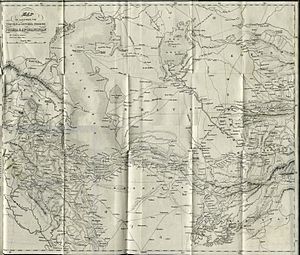
In 1856, Persia attacked Herat. The British government declared war on Persia. The Anglo-Persian War lasted until 1857. Then, Persia and Britain both pulled back. Persia signed a treaty giving up its claim on Herat.
Further Expansion
Under British Rule
After the Indian Rebellion of 1857, the British government took over control from the East India Company. Queen Victoria became the Empress of India in 1876. The British Raj (British rule in India) managed a system of connected markets using military power and laws. The Government of India Act 1858 meant the India Office in the British government ran British India through a Viceroy appointed by the Queen.
In 1863, Sultan Ahmad Khan of Herat, who was put in power by Persia, attacked the town of Farrah. Farrah had been under Dost Mohammad Khan's control since 1856. He responded by sending his army to defeat Herat and reunite it with Afghanistan.
Under Russian Rule
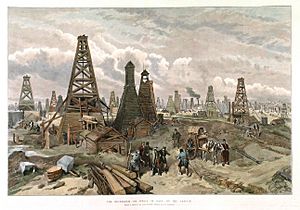
The Crimean War ended in 1856 with Russia's defeat by Britain, France, and the Ottoman Empire. The new Russian ruler, Alexander II, waited a few years to avoid upsetting the British. Then, Russia expanded into Central Asia in two ways. In 1864, the Russian Chancellor, Gorchakov, sent a message to foreign officials. He explained that Russia needed to expand to bring civilization and protect trade routes. The first expansion started from Orenburg and moved towards Kabul in Afghanistan. Russia took Chimkent in 1864, Tashkent in 1865, Khokhand and Bukhara in 1866, and Samarkand in 1868. Russia's influence now reached parts of Afghan Turkestan. The second expansion started from the Caspian Sea and moved towards Herat, near the Persian border. Khiva was taken in 1873. Russian forces also seized Krasnovodsk (now in Turkmenistan) in 1869.
From 1869 to 1872, Mir Mahmud Shar gained control of the Khanate of Badakhshan. He had help from Afghanistan's new ruler, Amir Sher Ali Khan. By 1873, Afghanistan governed Badakhshan.
Tibet and Inner Asia
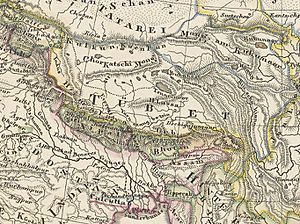
Britain and Russia also competed in Tibet and "Inner Asia." Russian leaders wanted to create a base to surround the Qing dynasty in Inner Asia. They also wanted a second front against British India from the northeast.
Britain had been exploring areas north of India. They hired "Pundits" (native Indian explorers) like Nain Singh. He reached Lhasa, Tibet, in 1866. He and his cousin Kishen Singh traveled around Tibet for many years. Russian explorer Nikolay Przhevalsky felt Britain was a threat to Russian goals in Inner Asia. He started his own expeditions in the 1870s. He didn't reach Lhasa, but he traveled widely in Tibet, Qinghai, and Xinjiang. Przhevalsky's trips became famous and increased Russian interest in Asia.
Britain worried about Russia's growing influence in Tibet. This was because of contacts between a Russian-born Buddhist monk, Agvan Dorzhiev, and the 13th Dalai Lama. Dorzhiev claimed Russia was a powerful Buddhist country that would ally with Tibet against China or Britain. In response, Britain tried to increase its own influence in Tibet. This was to create a buffer for British India. British forces, led by Sir Francis Younghusband, invaded Tibet in 1904. They made a treaty with the Tibetans, the 1904 Lhasa Convention.
The Empire of Japan also watched the Great Game. They took part indirectly through talks and spying. For example, Japan hosted Abdurreshid Ibrahim, a Muslim leader who opposed Russian and British expansion. Japan's interest in the region and its dislike of Russia led to the Anglo-Japanese Alliance. Later, the Russo-Japanese War also changed Russia's plans in Xinjiang.
Carl Gustaf Emil Mannerheim also worked as a Russian agent during the Great Game. He led an expedition through Tibet, Xinjiang, and Gansu on his way to Beijing. The Russian military wanted information about the Qing dynasty and if it was possible to invade Western China. This was part of their fight with Britain for control of Inner Asia. Mannerheim, disguised as a collector, joined a French expedition in Samarkand in 1906. He later traveled mostly alone. Mannerheim met the 13th Dalai Lama and acted as an envoy for Russia.
Persia
Many writers connect the British-Russian competition in Iran to the Great Game. This competition continued until the Anglo-Russian Entente in 1907. After that, Britain and Russia mostly worked together to gain influence in the region until the Russian Revolution.
The Great Game in Iran involved military actions, diplomatic tricks, and competition over trade goods. Russian settlers moved into northern Iran. Even though Britain was known for its industry and trade, Russia saw itself as directly competing with Britain for trade in Iran and other nearby markets. Russian travel writings from the late 1800s suggest that Russian trade became dominant in northern and western Iran. Russia also gained control over valuable resources, like a monopoly on caviar in the southern Caspian Sea.
After the 1828 Treaty of Turkmanchay, Russia gained control over land in Iran. Russia then supported the weakened Qajar dynasty in Iran. This Russian control of Persia continued for almost a century. The Persian monarchy became more of a symbol. Russian diplomats had real power in Iran, and the monarchy depended on British and Russian loans. In 1879, Russian officers formed the Persian Cossack Brigade. This gave Russia influence over the modernization of the Qajar army. By the 1890s, Russian teachers, doctors, and officers were important at the Shah's court. They influenced his decisions.
Russia and Britain both invested in building roads and telegraph lines in Iran. This was a way to make money and spread their influence. However, until 1907, their rivalry was so strong that they both demanded the Shah exclude the other. This stopped all railroad building in the late 1800s. In 1907, Britain and Russia agreed to divide Iran into zones of influence. Britain got southeastern Iran, and Russia got northern Iran.
Tsar Nicholas II strongly supported the Shah against revolutionaries. This led to a large Russian intervention with troops and the Persian Cossacks. The Russians failed to fully stop the Persian Constitutional Revolution. But the Cossack Brigade remained very powerful. An Iranian former Cossack, Reza Shah, later started the Pahlavi dynasty.
Second Anglo-Afghan War
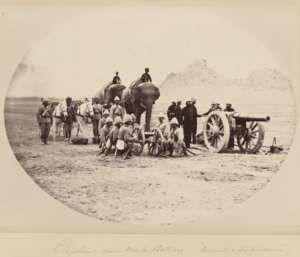
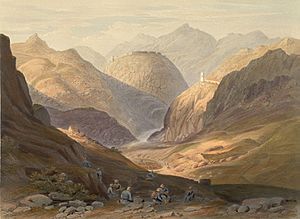
In 1878, Russia sent troops on an uninvited diplomatic mission to Kabul. Sher Ali Khan, the Amir of Afghanistan, tried to stop them, but the Russians arrived in Kabul on July 22, 1878. In response, on August 14, Britain demanded that Sher Ali also accept a British mission. The Amir refused and threatened to stop it if it tried to enter his country. Lord Lytton, the Viceroy of British India, ordered a British envoy to Kabul in September 1878. The mission was turned back at the Khyber Pass. This started the Second Anglo–Afghan War. In November 1878, 40,000 men from the British Raj invaded Afghanistan from British India. The fighting stopped for a while after talks in 1879. But in 1880, fighting started again after a British envoy in Kabul was killed.
Diplomacy
Agreement Between Great Britain and Russia 1873
On January 21, 1873, Britain and Russia signed an agreement. It stated that the eastern Badakhshan area and the Wakhan Corridor were Afghan territory. The northern Afghan border was the Amu Darya (Oxus River). A joint Russian-British group would define the border from the Amu Darya to the Persian border. However, no border west of the Amu Darya was set until 1885. This agreement defined the British and Russian areas of influence in Afghanistan and Central Asia. It also led to Russia taking over the Khanate of Khiva that same year. Badakhshan was later divided between Afghanistan and Russian-controlled Bukhara in 1895.
Treaty of Gandamak, 1879
After the British Siege of Kabul, the war was settled by the Treaty of Gandamak in 1879. This treaty required Amir Abdur Rahman Khan to accept British control over Afghanistan's foreign policies. He kept control over internal matters. He also had to give Britain some southern border areas. The British sent an envoy to Kabul, but on September 3, this mission was killed. The conflict started again. The second phase ended in September 1880 when the British defeated Ayub Khan outside Kandahar. A new Amir, chosen by the British, confirmed the Gandamak treaty again. When the British and Indian soldiers left, the Afghans agreed to let the British achieve their goals. This created a buffer between the British Raj and the Russian Empire.
In 1881, Russian forces took Geok Tepe. In 1884, they occupied Merv. Since Russian forces were close to Herat, the British and Russian governments formed a joint Afghan Boundary Commission that same year. Their job was to define the borders between the Russian Empire and northern Afghanistan.
In 1885, a Russian force took over the Panjdeh district north of Herat province. This event is called the Panjdeh incident. The Afghans said the people of Panjdeh had always paid taxes to Afghanistan. The Russians argued that this district was part of the Khanates of Khiva and Merv, which they had already taken. The Afghan Boundary Commission was supposed to settle the dispute, but the battle happened before they arrived. The Afghan force of 500 was defeated by more numerous Russian soldiers. Britain did not help Afghanistan, even though the Treaty of Gandamak required it. This made the Amir believe he could not rely on the British against Russian attacks.
German Chancellor Otto von Bismarck understood how important the Great Game was for Russia and Britain. Germany had no direct interest, but its power in Europe grew when Russian troops were far away. For over two decades (1871–1890), he tried to help the British. He hoped to force the Russians to send more soldiers to Asia. However, Bismarck also helped Russia by pressuring the Ottoman Empire to block the Bosporus from British ships. This forced Britain and Russia to talk about Afghanistan.
Protocol Between Great Britain and Russia 1885
On September 10, 1885, Britain and Russia signed an agreement in London. This agreement defined the border from the Oxus to the Harirud river. More agreements followed between 1885 and 1888. The Afghan Boundary Commission agreed that Russia would give up some land it had taken, but keep Panjdeh. The agreement set a permanent northern Afghan border at the Amu Darya. Afghanistan lost a lot of land, especially around Panjdeh.
This left the border east of Lake Zorkul in the Wakhan region to be defined. China, Russia, and Afghanistan all claimed this land. In the 1880s, the Afghans had moved north of the lake. In 1891, Russia sent troops to this area. Their commander, Yanov, ordered the British Captain Francis Younghusband to leave. The Russians claimed they owned the Pamirs because they had taken the Khanate of Kokand. Afghanistan said the region had never paid taxes to Kokand and was independent. So, they claimed it. The British said this broke the 1873 Anglo-Russian Agreement. But the Indian government pointed out that the area was not in the agreement.
In 1892, the British sent Charles Murray, 7th Earl of Dunmore to the Pamirs to investigate. Britain worried that Russia would take advantage of China's weakness there. Murray was involved in some kind of diplomacy or spying. In 1893, he reached an agreement with Russia to mark the rest of the border. This was finished in 1895.
Agreement Between Great Britain and Afghanistan 1893
On November 12, 1893, Britain and Afghanistan signed an agreement in Kabul. This agreement confirmed the 1873 agreement. It required Afghanistan to leave the land north of the Amu Darya that it had taken in 1884. It also called for marking the border east of Lake Sari.
When Mortimer Durand, a British official, was put in charge of the Gilgit Agency (now part of Gilgit-Baltistan in Pakistan), he developed the region. He built roads, telegraphs, and mail systems. He also talked with the Mir of Gilgit. He wanted to improve the road from Kashmir through the states of Hunza and Nagar to the Russian border. The Mirs of Nagar and Hunza saw this as a threat. In 1890, Durand strengthened Chalt Fort near the border. This was because of rumors that Nagar and Hunza fighters would attack it. He kept building the road to the fort. In May 1891, Nagar and Hunza warned Durand to stop work on the road and leave the fort. They said they would see it as an act of war. Durand reinforced the fort and sped up road construction. This made Nagar and Hunza stop mail from the British Resident in Chinese Turkmenistan. British India saw this as breaking their 1889 agreement with Hunza. After an ultimatum was ignored, they started the Anglo-Brusho Campaign of 1891. Hunza and Nagar came under British protection in 1893.
Anglo-Russian Convention of 1907

In the Anglo-Russian Convention of 1907, the Russian and British Empires officially ended their rivalry. They decided to focus on opposing the German Empire. In this agreement, Russia recognized Afghanistan and southern Iran as part of Britain's area of influence. Britain recognized Central Asia and northern Iran as part of Russia's area of influence. Both countries recognized Tibet as neutral. However, Russia had special rights to talk with the Dalai Lama, and Britain had special rights in Tibetan trade deals.
For a time, Britain and Russia worked together against Germany. They also worked against a movement in Iran that wanted a constitution. This movement threatened their shared influence. Russia had already set up the Persian Cossack Brigade in 1879. This force was led by Russian officers and helped Russia gain influence in Iran.
In 1908, the Persian Constitutional Revolution tried to create a democratic society in Iran. It wanted an elected parliament and a free press. To solve the Qajar dynasty's money problems, the parliament hired an American financial expert, Morgan Schuster. He later wrote a book criticizing Britain and Russia.
The Russian Empire interfered in the Persian Constitutional Revolution to support the Shah and end the constitution. The Cossacks attacked the parliament in June 1908 and took over Tehran. More Russian army brigades were sent to help the Shah. They also occupied Tabriz after April 1909. However, the constitutionalists were able to retake the capital in July 1909. They removed Mohammad Ali Shah Qajar, who went into exile with the Russians. A new ruler, Ahmad Shah Qajar, found it hard to completely reverse the reforms. But the Qajar state was weakened, and the court depended on foreign loans. Meanwhile, Britain and Russia worked together to force Shuster out of Iran with an ultimatum in 1911. The parliament rejected it. British and Russian officials coordinated as the Russian army invaded the capital again and stopped the parliament. The Tsar ordered troops to act "harshly and quickly." Many revolutionaries were executed. By June 1914, Russia controlled its northern zone. Britain had influence over tribal leaders in the southeastern zone. Qajar Iran became a battleground for Russian, Ottoman, and British forces in World War I.
When Did the Great Game Happen?
Historians don't fully agree on when the Great Game started or ended. Some believe it began with Russia's victory in the Russo-Persian War (1804–13) in 1813 or 1828. Others think it started between 1832 and 1834 with British attempts to make trade deals. Some say it began after the Caucasian War (1828–59) and got stronger during the Crimean War (1853–56). Some historians say it ended after the First Anglo-Afghanistan war in 1842 when the British left Afghanistan.
British worries ended in 1907. The Great Game officially closed in 1907 when Britain and Russia became military allies (with France). They made three agreements that set out their areas of interest in Persia, Afghanistan, and Tibet. However, some historians say it ended with the Bolshevik Revolution in 1917. This temporarily ended Russia's interest in Persia.
How the Great Game Shaped Today's Borders
Impact on India
Narendra Singh Sarila, an aide to Lord Louis Mountbatten (the last British Viceroy of India), wrote a book in 1948. He said that the partition of India (dividing it into India and Pakistan) was partly linked to the Great Game between Britain and the Soviet Union. He stated that Britain realized Indian leaders would not cooperate militarily after independence. So, they supported those who would, using religion. Their problem could be solved if Mohammad Ali Jinnah, the leader of the Muslim League, succeeded in creating a separate state called Pakistan in northwest India. This new state would border Iran, Afghanistan, and Xinjiang.
A lawyer named Aman M. Hingorani wrote that Winston Churchill asked his War Cabinet to plan how to protect British interests in India. A report in 1945 said Britain "must retain its military connection with the subcontinent to ward off the Soviet Union’s threat." It listed four reasons for India's importance:
- India was a base for troops in the Indian Ocean, Middle East, and Far East.
- It was a transit point for air and sea travel.
- It had a large reserve of good fighting men.
- The northwest region was important to threaten the Soviet Union.
Images for kids
-
Map of the Indus River basin today. Britain wanted to use steam power and the river for trade into Central Asia.
-
A Siberian Cossack around the 1890s.
-
The Discoverers, a statue in Balkanabat, Turkmenistan. It shows early oil prospectors in the Balkan Province.
-
British military officer Alexander Burnes (1805-1841), linked to the Great Game.
-
Political cartoon from 1878. It shows the Afghan Emir Sher Ali with his "friends," the Russian Bear and British Lion.
-
Russian Empire land gained each year in Central Asia up to 1885.
-
Map of northern Persia and northern Afghanistan in 1857. It shows Khiva, Bukhara, and Kokand, which are now parts of Turkmenistan and Uzbekistan.
-
Oil Wells at the Caspian Sea, 1886.
-
Tibet before 1859.
-
Elephant and Mule Battery during the Second Anglo-Afghan War.
-
Khyber Pass with Ali Masjid fort in 1848.
-
Influence zones in Iran after the Anglo-Russian Convention of 1907.
-
A silk and spice festival in modern-day Bukhara, Uzbekistan.
-
1909 map of the British Indian Empire. British India is shown in pink, and the princely states are in yellow.
See also
 In Spanish: El Gran Juego para niños
In Spanish: El Gran Juego para niños


